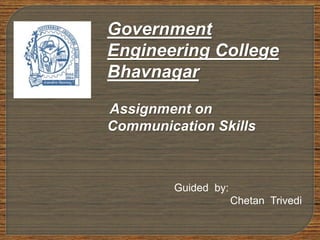
"Kinesics"
- 1. Government Engineering College Bhavnagar Assignment on Communication Skills Guided by: Chetan Trivedi
- 2. Topic: Kinesics Prepared by: Name Enrollment no. Solanki Vishvata 140210107061 Vora Keval 140210107062 Vyas Rudri 140210107063 Patel Nirmit 140210107064
- 3. The ability to speak and communicate is the only difference between Animals and Human beings. It’s due to effective communications skills that humans interact with one another as a social being.
- 5. According to research conducted by Albert Mehrabian it is shown that when someone has given a spoken message, only 7% of the listener understands the message and judgment of the message comes from the words, 38% from the way, the message was spoken(accent, tone, inflection etc.) and 55% from the speaker’s body language(facial expressions, eye contact etc.)
- 6. Body movement and gestures
- 7. Kinesics is the interpretation of body motion communication such as facial expressions and gestures — that is, nonverbal behavior related to movement of any part of the body or the body as a whole. The equivalent popular culture term is body language .
- 8. Kinesics Gestures Facial Expression Body language Postures
- 9. Nonverbal indicators of dislike • Indirect, oblique body orientation • No eye contact, or eye contact of short duration • Averted eyes • Unpleasant facial expressions • Relative absence of gestures • Body rigidity, bodily tension • Incongruent postures
- 11. Humans have uniquely expressive hands.
- 12. The meaning of a gesture depends on its context • flipping someone the “bird” could be serious or playful. Gestures may be conflicting • Yawning while saying you are not tired. • Looking involved but saying, “I don’t care
- 14. Emblems are used intentionally. They have verbal equivalents They have a clear, consistent meaning within a particular culture • Cross my heart • Shame on you • Peace sign • I’m crazy
- 15. Emblems are nonverbal signals that can generally be translated directly into words. Most people within a culture or group agree on their meaning. A good example is the "A-OK" symbol made with the thumb and forefinger. Because these gestures can be directly translated into words, they are quick to use and unambiguous in their meaning. However, as we noted earlier, culture quickly comes into play when you move outside of your "home" culture. For instance, in many parts of the world this gesture is directly translated as "OK", but in other places it might be translated as "Zero" or "None", and in others it is even understood to represent an obscene gesture representing a body orifice Quite a different interpretation than being OK!
- 16. Illustrators are movements that complement verbal communication by describing or accenting or reinforcing what the speaker is saying. People use illustrators to indicate the size of an object or to draw a picture in the air or to emphasize a key word in what they are saying. These might include pointing to an object in the room or pounding on the table The frequency of use of illustrators may vary by culture, but they are used widely. Use of illustrators can help indicate interest, efforts to be clear or enthusiasm for the topic being discussed
- 17. Affect displays may or may not be intentional Affect displays convey feeling and emotion They are often communicated via facial expressions They can be difficult to interpret Interpreting affect displays: • Look at the face to determine the emotion • Look at body cues to determine the strength or intensity of the emotion.
- 18. Affect displays are nonverbal displays of the body or face that carry an emotional meaning or display affective states. Our gait (bouncing, suggesting happiness for instance, or slouched and shuffling, suggesting depression), and our facial movements (breaking into a big grin, suggesting pleasure, or frowning suddenly indicating displeasure) send a message about our feelings. Affect displays are often spontaneous and thus they may send signals that we would rather not convey based on social norms or our goals for communication • We will explore facial expressions more in a later section.
- 19. Regulators are nonverbal messages that accompany speech to control or regulate what the speaker is saying These might including the nodding of the head to indicate you are listening or understanding something, for instance, and you are encouraging the speaker to continue. Regulars are often associated with turn-taking in conversation, influencing the flow and pace of discussion. For instance, we might start to move away, signaling that we want communication to stop, or we may raise a finger or lift our head to indicate we want to speak, or perhaps show our palm to indicate we don't want a turn at speaking
- 20. Regulators are primarily unintentional They regulate turn-taking behavior Conversational give and take depends on regulators Types of turn-taking Turn-requesting cues Turn maintaining cues Turn yielding cues Turn denying cues
- 21. Hair twirling is an adaptor, but does it always mean the same thing?
- 22. Adaptors are forms of nonverbal communication that often occur at a low level of personal awareness. They can be thought of a behaviors that are done to meet a personal need as one adapts to the specific communication situation. They include behaviors like twisting your hair, tapping your pen, scratching, tugging on your ear, pushing your glasses up your nose, holding yourself, swinging your legs, etc. Given the low level of awareness of these behaviors by the person doing them, the observer is sometimes more aware of the behaviors than the doer of them. Adaptors may thus serve unintentionally as clues to how a person is feeling. Adaptors are not intended for use in communication, but rather may represent behaviors learned early in life that are somehow cued by the current situation and which may be increased when the level of anxiety goes up in the situation.